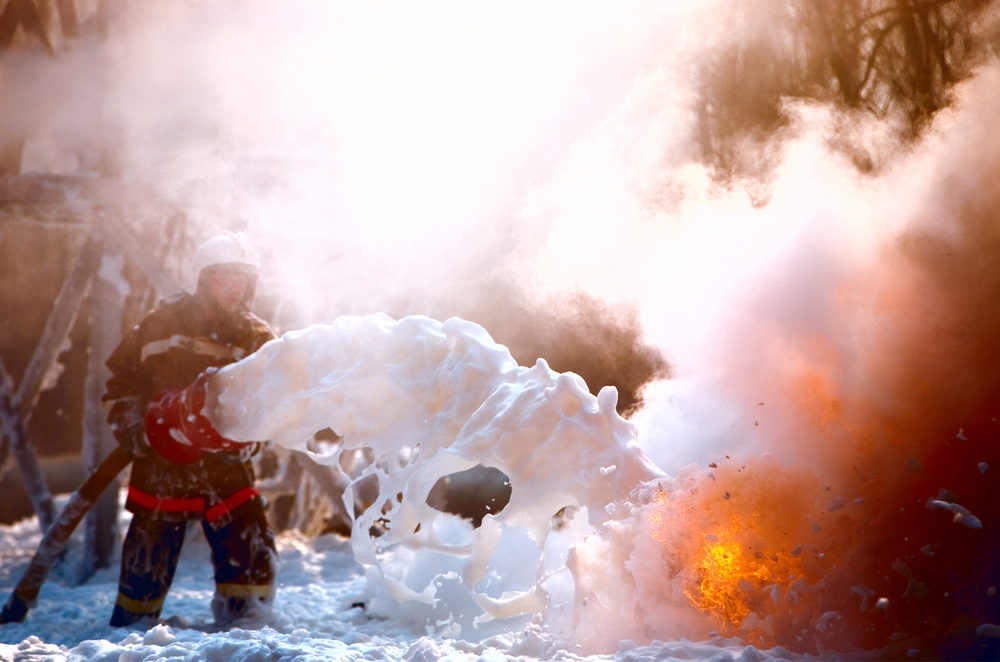States Are Trying to Restrict the Use of Firefighting Foam Due to Potential Health Risks
For decades, a synthetic foam concentrate has been a crucial tool for firefighters fighting blazes caused by flammable liquids. But the chemicals in aqueous film-forming foam (AFFF) that make it so effective have been linked to severe illnesses like cancer, thyroid disease, and kidney and liver toxicity. Along with health hazards, AFFF is hugely detrimental to the environment. It can seep into the soil, contaminate water supplies, and poison wildlife. In response, states and the federal government are restricting the use of the foam in hopes of mitigating the risks to the general public.
Dangers of PFAS
Per- and polyfluoroalkyl substances, more commonly known as PFAS, are called “forever chemicals” because they take decades — sometimes centuries — to break down in the environment. They also linger in the human body for up to eight years after exposure. They are used in food packaging, cosmetics, cookware, stain-resistant fabrics, and numerous other consumer products.

In firefighting foam, PFASs act as surfactants that help cool and suppress a fire, making it difficult to continue to spread. When the foam was invented in 1966, it became popular with the U.S. military. Soon after, the potential adverse effects became apparent in animal studies. In the 1970s, the Navy began to research whether the possible consequences of AFFF outweighed the benefits. Nearly 50 years later, the foam is still in use worldwide. Thousands of firefighters, military members, and civilians have sued foam manufacturers, alleging that they failed to warn users about the potential consequences of long-term exposure.
Since the dangers of AFFF have become apparent, environmental groups and people injured by foam exposure have urged local and federal governments to enforce penalties for firefighting foam use. These groups have pushed firefighting agencies to find alternative suppressant options. While some progress has been made, an exact substitute isn’t yet available. Fluorine-free foam that doesn’t contain PFAS chemicals has emerged as a promising option, but firefighters must use more to extinguish a blaze, making it less cost-effective. Another drawback is that its efficacy varies depending on the manufacturer. When firefighters are using AFFF, they’re encouraged to wear personal protective equipment to help reduce the chances of exposure.
States Respond to Firefighting Foam Risk
More than a dozen states have banned firefighting foam that contains PFAS chemicals, and many have passed regulations on the production, use, and disposal of aqueous film-forming foam in recent years. The rules vary in restrictiveness. Some states have banned AFFF in fire and military training and only allow the foam to be used in active fires. States like Connecticut and Vermont have implemented take-back programs to incentivize people to safely dispose of existing firefighting foam. Some regions that haven’t banned AFFF have enacted stricter reporting requirements to ensure that the state knows when and how the foam is used.
In 2019, New York State Attorney General Letitia James announced plans to sue several AFFF foam companies. Michigan followed suit and brought lawsuits against 33 AFFF companies the following year. The state attorney general alleged that the manufacturers intentionally, knowingly, and recklessly supplied AFFF even though they knew the foam could contaminate natural resources and cause human injury.
In February, Colorado governor Attorney General Phil Weiser sued 15 companies that manufacture PFAS-containing firefighting foam, alleging that they knew or should have known about the probable effects of exposure. Weiser said in a press release that the chemicals had damaged the state’s public health and natural resources. The state asked that manufacturers pay for all costs of cleaning up AFFF-contaminated sites.
Late last year, North Carolina sued 3M and 13 other businesses for the same reason. The state asked the courts to order manufacturers to pay for PFAS cleanup at an airport, air bases, and a firefighting training site. The state attorney general also sought punitive damages. 3M said it planned to defend its health and safety record in court in response.
Firefighting foam lawsuits have been consolidated into multidistrict litigation (MDL) to streamline proceedings and speed up settlements. Some of the cases brought by state governments have been sent to the existing MDL, joining thousands of other civilian complainants. The first test trials are scheduled for early 2023.










